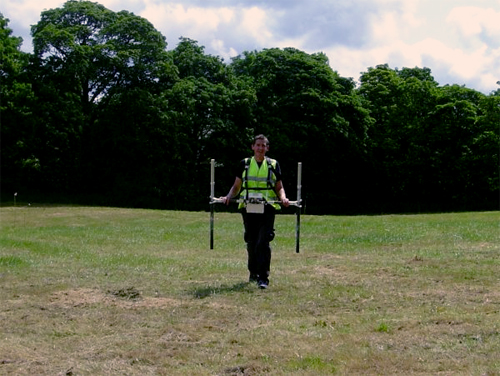
Last month Chorley Archaeological Society was able to carry out a geophysical survey of the field just south of Coppull Moor Lane. This field is on the line of the Roman road between Wigan and Walton-le-Dale and was excavated by the Chorley Society in the late 60's and early 80's. They found tentative evidence of the road on the both northern and southern edges and so the idea of this survey was to show that road extended right across the field. This survey was carried out by David Harrison, a professional working for Archaeological Services WYAS based in Leeds. He also happens to be the son of the Society treasurer, John Harrison, and so the survey was carried out as a favour to the Society.
This was a great opportunity for David to demonstrate is hi-tech equipment including: hi-res GPS, Magnetometer and Resistivity equipment. Using his GPS he was able to mark out an accurate grid of the entire field. The Magnetometer survey followed in quick succession. The Resistivity survey, however, took much longer despite his equipment being able to take double readings with its extended frame.
The Magnetometer result identified quite clearly, an old field boundary which appears on the 1849 - 6 inch map, but no sign of the road. This was not too disheartening as this type of survey is not particularly suited for this work. The Resistivity result, however, was much more promising with a large area of hi-res activity running roughly northsouth across the field. Unfortunately this was slightly off to the west of the projected line of the road and was not particularly well defined. The result was therefore generally inconclusive but a target area for a future excavation has certainly been identified (more details on our Forum and Chorley's Website). David has also indicated that he is quite willing to offer his services if we need any surveying.
Rectory update
Work has been continuing at the Rectory over the last couple of months despite the changeable weather. The most recent activity has been on our original trench in Area 1. We made the decision last month to remove the water feature to try to confirm for certain that the dirt track did, indeed, continue beyond the deep trench (which cuts through it on the north side). Sure enough, with the cast iron feature removed, the evidence for the track and underlying sand was revealed. However, what we didn't expect was yet more archaeological layers lying beneath it. What we've found is an undulating cobble surface lying under a layer which is producing pottery dating to the 17th/18th century. What this represents is difficult to understand - whether it was an earlier track or entrance to the Hall is uncertain at this stage (it looks like we've still got plenty work in this area - again more details on our
Forum).
Summer Trip
Our trip is now confirmed for Sunday 21st August. In the morning we will be visiting the Iron Age Hill Fort site of Caer Allyn near Wrexham, where Phil Cox has been excavating. He will be giving us a guided tour of his most recent work. In the afternoon, we will be visiting the Roman town of Wroxeter near Shrewsbury (entrance fee £4.80 & £4.30 concession). Shrewsbury itself has been suggested for the final destination although other sites are possible (i.e. Buildwas Abbey or Coldbrookdale Museum). Please let me know at the next meeting if you are intend going, so we can work out the travel arrangements.
Next Meeting
Wednesday 6th July - this month we have been given the opportunity to have a guided tour of Wigan's All Saints Parish Church. We will therefore be meeting outside the Church at 7.30pm (which is our usual time). Our tour guide is Peter Layland, who will start the tour with a short talk on the Church's history. Peter, who is a member of our Society, has an in-depth knowledge of the Church having spent some time completing a paper on the subject (which he has kindly offered to us for our website).
All Saint's Church has a long and fascinating history; it may even have a Saxon origin. It is certainly considered by many to be the 11th century 'Church of the Manor' mentioned in the Doomsday Book. Nothing survives from this period now, although a stone block embedded in a window on the north side could well be part of a Roman altar. Most of the present Church is a 19th century rebuild, however the tower, which has been altered over the years, dates from at least the 13th century. There are also other sections of the Church which survive from the Medieval period, such as the Walmseley and Bradshaigh Chapels (the later contains the effigies of Lord and Lady Bradshaigh - of Mab's Cross fame). It is a tour not to be missed - hope to see you there, - BA
|



